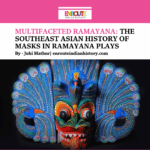Article Written By EIH Researcher And Writer
Barnak Das
The city of Lucknow, located on the banks of the river Gomti, remained a capital under Nawabi rule for eighty years. Under the rule of the Nawabs, three new palaces were built. They are the Macchi Bhawan, Chattar Manzil and the Daulat Khana. The final and most elaborate of them all, the Kaiserbagh palace, was built as the last royal monument before the British took over the city following the uprisings of 1857-58.
The last Nawab of Oudh, Nawab Wajid Ali Shah, started the construction of Kaiserbagh as soon as he ascended the throne in 1847. It was located southeast of the Chattar Manzil palace, built by his predecessor Nawab Sadat Ali Khan. The name Kaiserbagh (or Qaiserbagh) has a fascinating history. Some say it was named so because the word ‘Kaiser’ implies ’emperor’ or ‘ruler’ in Germanic languages. It may have been that Wajid Ali was impressed by the word and took it to name the ruler/king’s palace. Others feel this explanation is highly improbable. For them, the palace was named Kesarbagh from the word Kesar (Saffron) becausemost of his key buildings were red, he called it Kaiserbagh – Kaiser meaning Saffron and Bagh for Garden. When the British heard this name, they mistook it for its nearest phonological version, Kaiser. After the Nawabi was abdicated, Lucknow came under British rule, and the Kaiserbagh retained its mistaken name.

Picture: Cloth Painting of Kaiserbagh, Lucknow. This painting is made when this palace was at its bloom before being destroyed in 1857-1858.
The central concept behind the architecture of the Kaiserbagh came from the terraces of heavens mentioned in the Quran. The first ruler who introduced this idea of recreating a heavenly garden or Chaharbag was Babur. It was then used as a signatory style in Mughal architecture. The Nawabs of Lucknow inherited this practice of constructing gardens with water fountains, orchards, and flower trees. In the Kaiserbagh, Wajid Ali Shah used the concept of heavenly gardens that imitated the beauty of paradise. Paintings and photographs dating prior to 1857 show that the Kaiserbagh had a well-maintained garden placed at the center.
Among all the historical monuments of Lucknow from the Nawabi period, only the Kaiserbagh complex was designed meticulously before its construction. The palace complex was designed with an intentional hierarchy of spaces. A visitor had no other option but to move from one court to another while walking through the complex. This was meant to instill a sense of awe and display the wealth of the Nawabs. It is also said that the path had a zig-zag route to make the visitor feel that the palace was larger and grander.

Kaiserbagh Baradari, 1880.
Inside the Kaiserbagh had three separate complexes. There were the public areas where the Nawab met his officials and subjects, and public ceremonies such as feasts and coronations took place. These areas were accessible to the royalty as well as the common subjects. Then there was the complex with the king’s and his officers’ residential quarters, the library, the treasury, hammams (bathing houses), and private mosques. Finally, there was the zenana complex, which had the queens’ quarters and female servants’ quarters.
Today, what remains of this once-majestic palace is the quadrangle known as the ‘Paree Khana’ where the king and his queens resided. Close to the main quadrangle of the complex were houses and quarters of the royal ladies. It was surrounded by a small mosque, marble pavilions, anda large kiosk called the Lanka. The Lanka was a tent-like structure with an elevated platform supported by eight pillars. The Nawab, Wajid Ali, used it during the monsoons. The palace complex had a series of courtyards enclosed by walls of different heights. Kaiserbagh had buildings like Kaiser Pasand, Chaulakhi, Lanka, and the tombs, all enclosed by walled structures. The Chaulakhi Kothi was made by Wajid Ali Shah’s barber Azim-Ullah Khan. While making the palace complex, the Nawab confiscated the building and made it a part of his palace. During the First War of Independence, the ChaulakhiKotha was supposedly the residence of Begum Hazrat Mahal.

View of the principal gateway into the Kaiserbagh, Lucknow by Robert and Harriet Tytler, 1858.
With the annexation of Awadh on 13th February 1856, and Nawab Wajid Ali Shah exiled to Calcutta soon after, the Nawabi court passed in the hands of his son Prince BrijisQadar with Begum Hazrat Mahal as the guardian. The Begum fortified Kaiserbagh and bravely fought the British from May 1857 to March 1858 when Lucknow and Kaiserbagh fell in the hands of the British.
In her book, Kaiserbagh: The Garden Palace of Lucknow, Neeta Das tells us what happened to the Kaiserbagh after British occupation. The British officer, W.H. Russell’s graphic description of the capture of Kaiserbagh shows that British Soldiers ran amok, smashing doors and breaking into rooms in search of portable loot. The things that they could not carry like marble statues, furniture, heavy draperies, and massive jade bowls, they striated in a frenzy of destruction. But it was not the loot, which damaged the palace as much as the British attitude to demolish Kaiserbagh and the city of Lucknow.

Kaiserbagh, Lucknow [General view taken from the tomb of Saadat Ali], John Edward Sache, 1870.
After the siege it had become clear to the British military that large palace complexes such asKaiserbagh, mosques, and big kothis must be seized and demolished since they provided convenient shelter to the enemy Indian forces. A letter from the Secretary of the Chief Commission to the Commissioner of Oudh clearly stated that “As to Buildings in Lucknow, the only one that I think it might be well to level to the Ground is the Kaiserbagh as that is the palace where our chief’ energies have resided during the rebellion.” The death sentence was thus passed over Kaiserbagh. The work of reshaping the unhealthy and indefensible city of Lucknow was given to Colonel Robert Napier of the Bengal Engineers. He produced a document known as the Memorandum on the Military Occupation of the City of Lucknow,’ dated 26 March 1858. Therein he proposed to open broad streets through the city and to demolish any enclosures not required for military purposes. Anything that came in the path of the proposed road was demolished. As a result, Kaiserbagh was slowly demolished and had wide streets passing through its main courtyards.
No other structure of Lucknow was as glorious as Kaiserbagh and none other was mutilated as badly. Today it requires great effort and imagination to recreate the vision of the palace complex as only a few structures of the Kaiserbagh palace remain.

The Lanka inside the Kaiserbagh
References
Das, N. (1998). Kaiserbagh: The garden palace of lucknow. UP Tourism



















